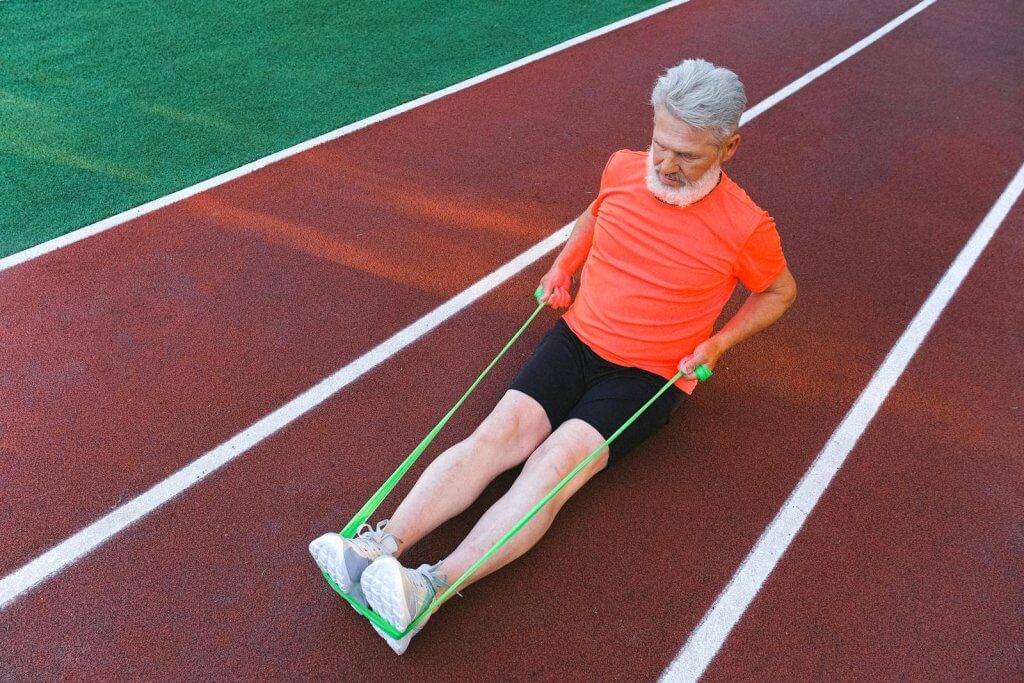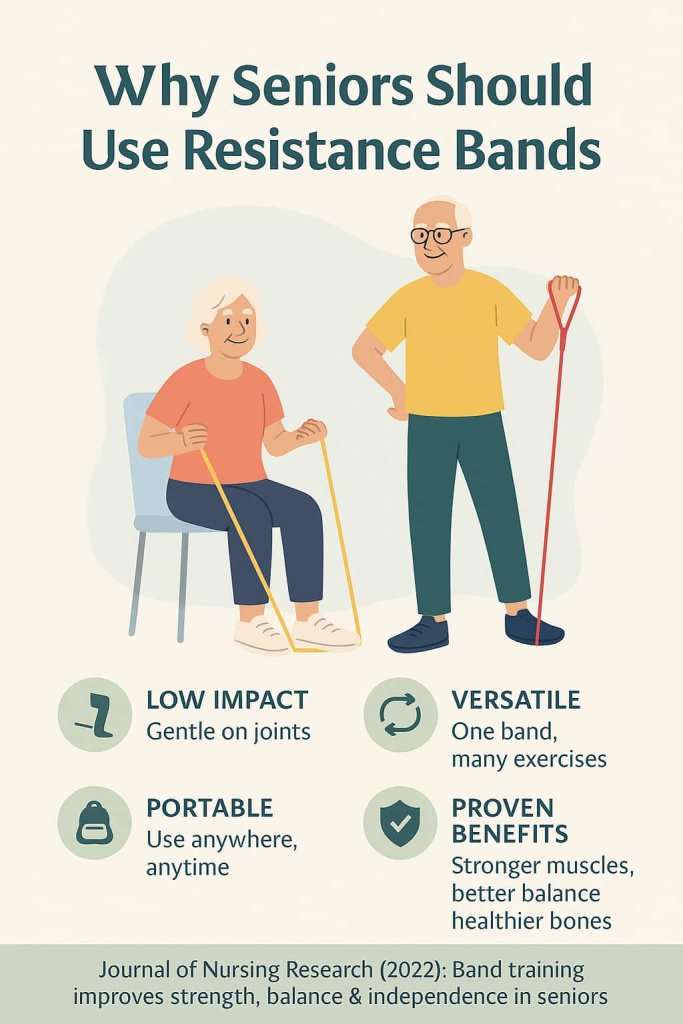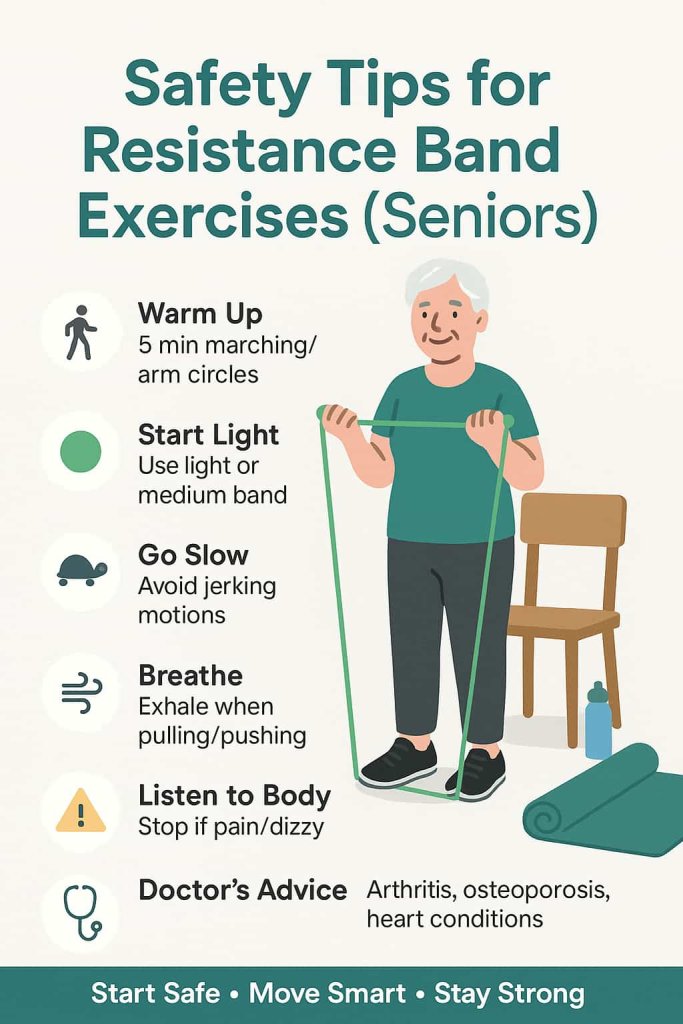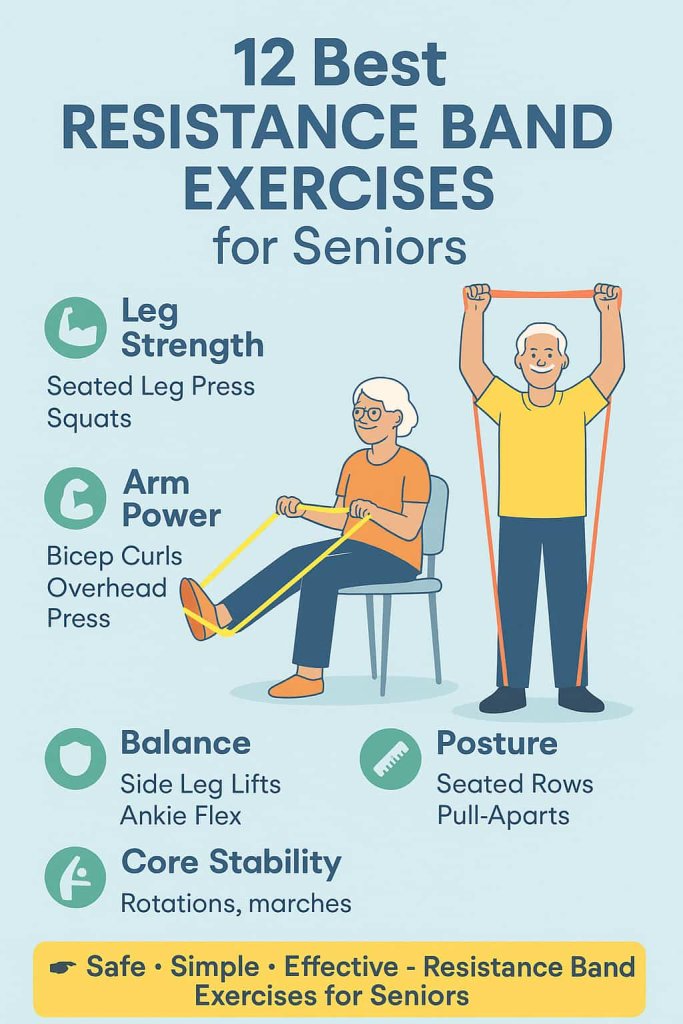Yes, seniors can safely use resistance band exercises to build strength, balance, and mobility. Resistance bands are lightweight, affordable, and joint-friendly, making them one of the safest strength-training tools for older adults.

Understanding how to use bands correctly helps prevent falls, improve independence, and keep daily activities easier. With just a few simple moves, seniors can improve leg power for walking, arm strength for lifting groceries, and core stability for balance.
In this guide, we’ll cover the 12 best resistance band exercises for seniors, how to do them step by step, and safety tips to get started confidently.
👉 According to the National Strength and Conditioning Association (2019), resistance training — including with bands — is safe and effective for older adults when tailored to individual needs (NSCA Position Statement).
Why Seniors Should Use Resistance Bands

- Low Impact – Bands are gentle on joints compared to heavy weights.
- Versatile – One band can train multiple muscle groups.
- Affordable & Portable – Easy to use at home, gym, or while traveling.
- Proven Benefits – Studies show band training improves strength, balance, bone density, and reduces frailty (Journal of Nursing Research, 2022).
Safety Tips Before Starting

- Warm up with 5 minutes of light marching or arm circles.
- Choose a light or medium band at first.
- Move slowly, avoid jerking motions.
- Breathe naturally — exhale when pulling/pushing.
- Stop if you feel pain or dizziness.
- Consult your doctor if you have arthritis, osteoporosis, or heart conditions.
12 Best Resistance Band Exercises for Seniors

Staying active as you age doesn’t always require heavy weights or fancy machines. Resistance band exercises are one of the safest, most effective, and affordable ways for seniors to build strength, improve balance, and support joint health.
Below are 12 of the best resistance band exercises for seniors, each explained step-by-step with trainer tips.
1. Seated Row with Band
Muscles worked: Upper back, biceps, posture muscles
How to do it:
- Sit tall on a sturdy chair, loop the band around your feet.
- Hold the ends of the band with palms facing each other.
- Pull your elbows back, squeezing shoulder blades together.
- Slowly release to the starting position.
Trainer Tip: Keep your chest lifted and avoid rounding your shoulders.
Why it helps: Strengthens posture muscles, helping reduce slouching and back pain.
2. Banded Chest Press (Seated or Standing)
Muscles worked: Chest, shoulders, triceps
How to do it:
- Anchor the band behind you (around a sturdy chair or door).
- Hold the ends at chest level.
- Press arms forward until fully extended.
- Slowly return to starting position.
Trainer Tip: Keep wrists straight to protect joints.
Why it helps: Improves pushing strength for daily tasks like opening doors or pushing shopping carts.
3. Seated Leg Press with Band
Muscles worked: Quads, glutes, hamstrings
How to do it:
- Sit on a chair, loop the band under one foot.
- Hold the ends in your hands.
- Press your foot forward to straighten the leg.
- Return slowly and switch legs.
Trainer Tip: Don’t lock your knee at full extension.
Why it helps: Builds lower body strength for walking, climbing stairs, and standing up easily.
4. Standing Side Leg Lifts
Muscles worked: Hip abductors, outer thighs, balance stabilizers
How to do it:
- Tie the band around your ankles.
- Stand tall, holding a chair for support.
- Lift one leg out to the side slowly.
- Lower with control and switch legs.
Trainer Tip: Keep torso upright—avoid leaning to the side.
Why it helps: Strengthens hips to reduce fall risk and improve balance.
5. Band Pull-Aparts
Muscles worked: Upper back, shoulders, posture stabilizers
How to do it:
- Hold the band with both hands at chest height.
- Keep arms straight and pull the band apart.
- Slowly return to the start.
Trainer Tip: Relax your neck and keep shoulders down.
Why it helps: Improves posture and counteracts the effects of prolonged sitting.
6. Seated Bicep Curls
Muscles worked: Biceps
How to do it:
- Sit tall, loop the band under your feet.
- Hold ends with palms facing upward.
- Curl hands toward shoulders.
- Lower slowly.
Trainer Tip: Keep elbows tucked close to your body.
Why it helps: Builds arm strength for carrying groceries, lifting objects, and daily activities.
7. Overhead Press with Band
Muscles worked: Shoulders, triceps
How to do it:
- Sit or stand on the band.
- Hold the ends at shoulder height.
- Press arms overhead until extended.
- Lower with control.
Trainer Tip: Keep your core tight and avoid arching your back.
Why it helps: Improves shoulder mobility and overhead strength for reaching high shelves.
8. Seated March with Band
Muscles worked: Hip flexors, thighs, core
How to do it:
- Sit tall and loop the band around your thighs.
- Lift one knee toward your chest.
- Lower slowly and alternate legs.
Trainer Tip: Maintain steady band tension for best results.
Why it helps: Builds core and leg strength for better walking endurance.
9. Standing Band Squats
Muscles worked: Quads, glutes, hamstrings
How to do it:
- Stand on the band, feet shoulder-width apart.
- Hold the ends at shoulder height.
- Bend knees and hips as if sitting into a chair.
- Stand back up tall.
Trainer Tip: Don’t let your knees cave inward.
Why it helps: Builds strength for sitting, standing, and daily mobility.
10. Band Ankle Flex (Seated)
Muscles worked: Calves, ankle stabilizers
How to do it:
- Sit tall, loop the band around the ball of your foot.
- Point toes forward, then flex back toward your shin.
- Repeat on both feet.
Trainer Tip: Great for circulation and ankle mobility.
Why it helps: Improves foot strength and stability, reducing the risk of trips and falls.
11. Band Core Rotations (Seated or Standing)
Muscles worked: Core, obliques, spine stabilizers
How to do it:
- Anchor the band to one side.
- Hold the ends with arms extended.
- Rotate your torso away from the anchor point.
- Return with control.
Trainer Tip: Keep hips still, rotate only the upper body.
Why it helps: Strengthens core for better balance and spinal support.
12. Band Deadlift (Hip Hinge)
Muscles worked: Hamstrings, glutes, lower back
How to do it:
- Stand on the band, feet hip-width apart.
- Hold ends in both hands.
- Hinge forward at the hips, keeping back straight.
- Return to standing by squeezing glutes.
Trainer Tip: Focus on glutes, not lower back.
Why it helps: Builds posterior chain strength, improving walking and standing endurance.
Programming: How Often Should Seniors Train?
- Frequency: 2–3 days per week.
- Sets/Reps: Start with 1 set of 8–12 reps, progress to 2–3 sets.
- Progression: Increase band tension or reps gradually.
- Rest: 1–2 minutes between sets.
Who Should Avoid or Modify Band Exercises?
- Seniors with severe joint pain, uncontrolled blood pressure, recent surgery, or severe osteoporosis should get medical clearance first.
- Always start with seated or chair-assisted variations if balance is an issue.
FAQ
1. Are resistance bands safe for seniors with arthritis?
Yes, but use light resistance and avoid painful ranges. Bands are joint-friendly.
2. Can resistance band training replace weights?
Yes, for most seniors. Bands provide enough resistance to build strength and improve function.
3. How long until results are noticeable?
Studies show strength gains in as little as 8–12 weeks with regular training.
4. Should seniors train upper and lower body on the same day?
Yes, full-body band workouts are efficient and recommended.
5. Do I need special bands for seniors?
No, but choose lighter resistance bands (yellow or red) and progress as strength improves.
6. What’s the best time of day for seniors to exercise?
Mid-morning or early afternoon, when energy is higher and joints are less stiff.
7. Can I do resistance band exercises daily?
Yes, but alternate muscle groups or keep sessions light to avoid overuse.
Conclusion
Resistance band exercises are one of the safest and most effective strength-training methods for seniors. They improve balance, mobility, posture, and independence while being easy on the joints.
Start small, stay consistent, and gradually progress. In just a few weeks, seniors can feel stronger, steadier, and more confident in daily life.
👉 Try adding 15–20 minutes of resistance band training 2–3 times per week to enjoy lasting health benefits.
